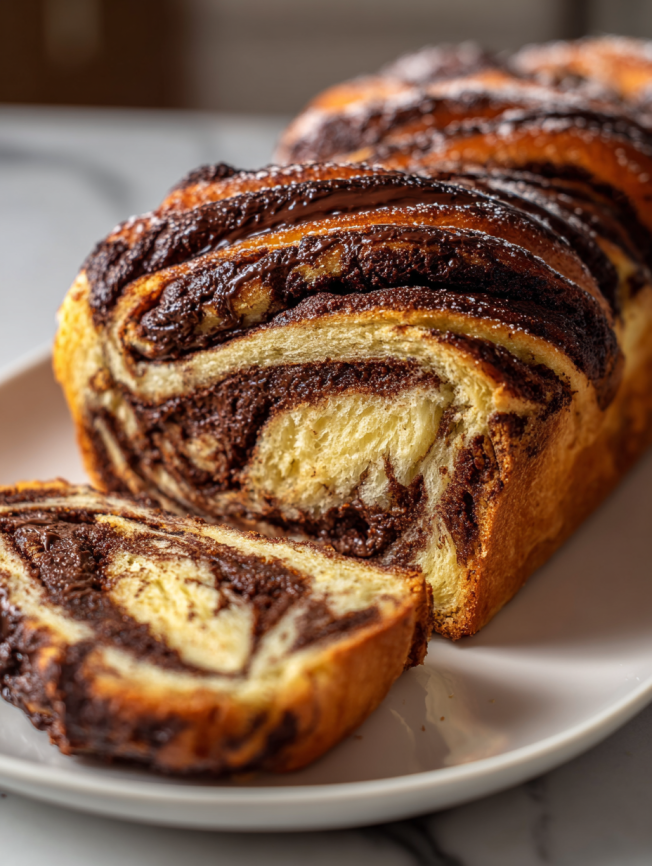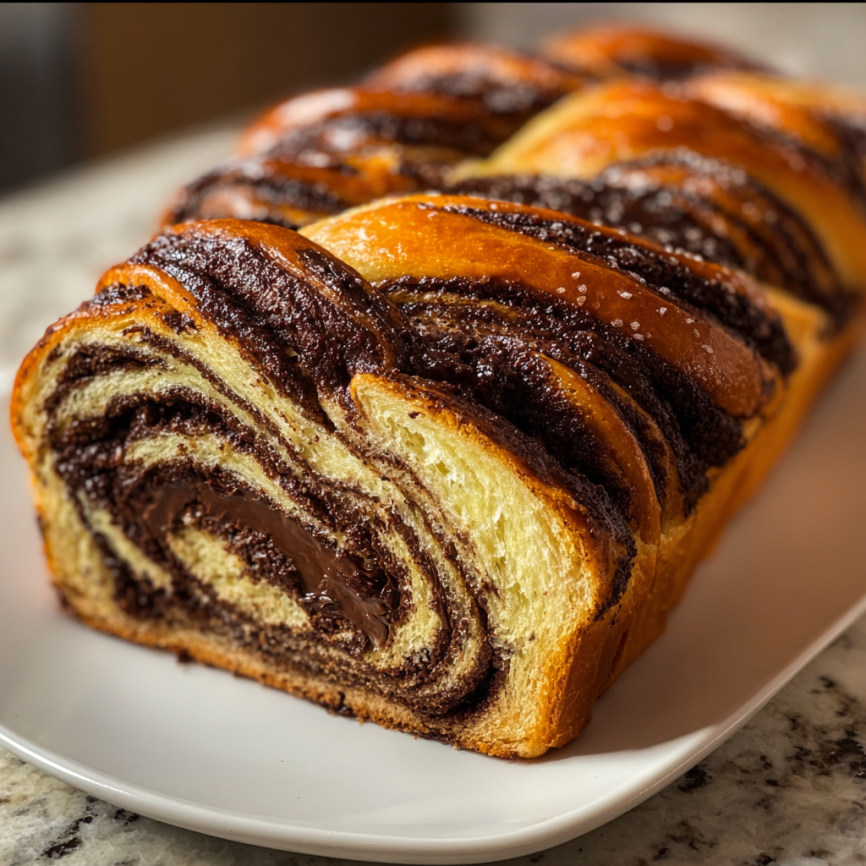The first time I witnessed someone cutting into a homemade chocolate babka, I was mesmerized by the beautiful swirls of rich chocolate spiraling through the tender, golden bread. This wasn’t just any dessert – it was a piece of culinary history, a testament to generations of Jewish bakers who perfected this sweet, yeasted masterpiece. Originally from Eastern Europe, babka has found its way into kitchens worldwide, bringing families together over its irresistible combination of buttery dough and decadent chocolate filling.
Why Chocolate Babka Will Become Your Signature Bake
A Show-Stopping Centerpiece
Few baked goods command attention like a perfectly twisted chocolate babka. The dramatic spiral pattern created by rolling and twisting the filled dough creates an Instagram-worthy presentation that never fails to impress guests and family members alike.
Versatility Across Meals
Unlike many desserts confined to after-dinner service, babka gracefully transitions from breakfast companion to afternoon treat to elegant dessert. Slice it thick for weekend brunch, serve it with coffee for an afternoon pick-me-up, or present it with vanilla ice cream for a sophisticated dessert course.
Rewarding Hands-On Experience
Working with yeasted dough provides a deeply satisfying, meditative baking experience. The process of kneading, watching dough rise, and creating those signature twists connects you to centuries of baking tradition while developing valuable bread-making skills.
Make-Ahead Convenience
Babka actually improves with time, developing deeper flavors as it rests. Additionally, the dough can be prepared ahead and refrigerated overnight, making it perfect for weekend baking or special occasion planning.
Essential Ingredients & Quality Guidelines
The Foundation: Dough Components
- 500g bread flour – Higher protein content creates the structure needed for proper rise and texture
- 100g granulated sugar – Feeds the yeast while adding sweetness to balance the rich chocolate
- 1 packet (2¼ tsp) instant yeast – Ensure freshness by checking expiration dates for reliable rising
- 240ml whole milk, warmed – Full-fat milk creates tender crumb; temperature should feel comfortably warm to touch
- 2 large eggs, room temperature – Easier incorporation and better emulsification when not cold
- 115g unsalted butter, melted and cooled slightly – European-style butter with higher fat content yields superior flavor
The Chocolate Heart
- 40g unsweetened cocoa powder – Dutch-processed cocoa provides deeper color and richer flavor
- 170g dark chocolate, chopped – Choose quality chocolate with 60-70% cocoa content for best results
- 1 tsp ground cinnamon – Adds warmth and complexity that complements chocolate beautifully
- 1 tsp salt – Essential for dough development and flavor enhancement
Shopping Success Tips
Purchase your chocolate from the baking aisle rather than candy section for better melting properties and flavor. Fresh yeast performs more reliably, so check expiration dates carefully before beginning your bake.
Step-by-Step Baking Journey
Activating Your Yeast Culture
Begin by warming milk to approximately 37°C – it should feel pleasantly warm but not hot when tested on your wrist. Combine this warm milk with sugar in a small bowl, then sprinkle yeast over the surface. Allow this mixture to rest for 5-10 minutes until it becomes foamy and fragrant, indicating active, healthy yeast.
Building the Dough Foundation
In a large mixing bowl, whisk together bread flour and salt, creating a well in the center. Pour the activated yeast mixture into this well, followed by room temperature eggs and slightly cooled melted butter. Using a wooden spoon or your hands, bring these ingredients together into a shaggy dough.
The Art of Kneading
Transfer your dough to a lightly floured work surface. Knead vigorously for 8-10 minutes, pushing the dough away with the heel of your hand, folding it back over itself, and rotating 90 degrees. The dough is properly developed when it becomes smooth, elastic, and springs back when poked gently.
First Rise Perfection
Place the kneaded dough in a greased bowl, turning once to coat all surfaces. Cover with a damp kitchen towel and place in a warm, draft-free location. During the next 1-2 hours, the dough should double in size, becoming light and airy.
Preparing the Chocolate Filling
While your dough rises, combine cocoa powder, chopped chocolate, and cinnamon in a medium bowl. This dry mixture will distribute evenly across the rolled dough, creating those signature chocolate swirls throughout the finished babka.
Shaping and Assembly Techniques
Creating the Perfect Rectangle
Once doubled, gently punch down the risen dough to release trapped gases. Transfer to a lightly floured surface and roll into a rectangle approximately 40cm x 30cm. The dough should be about 6mm thick – thin enough for easy rolling but thick enough to contain the filling.
Filling Distribution Strategy
Sprinkle the chocolate mixture evenly across the rolled dough, leaving a 2cm border on all edges. This border prevents filling from leaking during the rolling and twisting process. Press the filling gently into the dough surface to ensure adherence.
The Signature Twist Technique
Starting from the long edge, roll the dough tightly into a log, pinching the seam to seal. Using a sharp knife, cut this log lengthwise down the middle, creating two long pieces with exposed chocolate layers. Twist these pieces around each other, cut sides facing up to showcase the beautiful spiral pattern.
Final Shaping and Pan Preparation
Carefully transfer your twisted babka to a greased 23cm x 13cm loaf pan. The twisted dough should fit snugly without being compressed. Cover with a clean kitchen towel and allow to rise for 30-45 minutes until slightly puffed and filling the pan nicely.

Baking to Golden Perfection
Oven Preparation
Preheat your oven to 175°C during the final rise time. Position a rack in the center of the oven to ensure even browning and proper heat circulation around the babka.
Monitoring the Bake
Bake for 30-35 minutes until the top is golden brown and the internal temperature reaches 88°C when tested with an instant-read thermometer. The babka should sound hollow when tapped gently on top.
Cooling Considerations
Allow the babka to cool in its pan for exactly 10 minutes – this brief rest prevents sticking while maintaining structural integrity. After this initial cooling, turn out onto a wire rack to cool completely, preventing soggy bottoms while preserving the tender crumb.
Serving Suggestions and Presentation Ideas
Traditional Service Style
Slice babka with a sharp serrated knife using a gentle sawing motion to preserve the delicate spiral pattern. Serve at room temperature to fully appreciate the tender texture and complex chocolate flavors.
Elevated Presentations
Transform simple slices into elegant desserts by serving with vanilla bean ice cream and a drizzle of warm chocolate sauce. Fresh berries add color contrast and bright acidity that balances the rich sweetness.
Breakfast and Brunch Options
Lightly toast slices and serve with butter, cream cheese, or your favorite jam. The toasting process enhances the chocolate flavors while creating pleasant textural contrast between crispy exterior and soft interior.
Creative Variations and Flavor Explorations
Nutty Additions
Incorporate 100g of toasted chopped walnuts or pecans into the chocolate filling for added texture and complementary flavors. Toast nuts lightly in a dry pan to enhance their natural oils and flavors.
Citrus Brightness
Add the zest of one orange to the chocolate filling for a bright note that cuts through the richness. Orange and chocolate create a sophisticated flavor combination that elevates this traditional recipe.
Seasonal Adaptations
During autumn months, consider adding a pinch of cardamom or nutmeg to the filling. Holiday versions might include dried cranberries or candied orange peel for festive appeal and additional flavor complexity.
Storage and Make-Ahead Strategies
Optimal Storage Methods
Wrap cooled babka tightly in plastic wrap or store in an airtight container at room temperature for up to 4 days. The flavors actually improve after the first day as they have time to meld and develop complexity.
Freezing Guidelines
Individual slices can be wrapped and frozen for up to 3 months. Thaw overnight at room temperature, then toast lightly for serving. Whole babkas freeze well but should be thawed completely before slicing.
Advanced Planning Options
The dough can be prepared through the first rise, then refrigerated overnight. This cold fermentation actually improves flavor development while allowing for flexible timing in your baking schedule.
Professional Techniques and Troubleshooting
Temperature Management
Successful babka requires attention to temperature at every stage. Use a kitchen thermometer to verify milk temperature, dough development, and doneness for consistent results every time you bake.
Dough Consistency Solutions
If your dough feels too sticky during kneading, add flour gradually – no more than 2 tablespoons at a time. Conversely, if the dough seems dry and won’t come together, add warm milk one tablespoon at a time until proper consistency develops.
Rise Time Variables
Environmental factors significantly affect rising times. Cooler kitchens require longer rising periods, while warm environments speed the process. Watch the dough rather than the clock, looking for proper doubling rather than adhering strictly to suggested timeframes.
Cultural Heritage and Traditions
Historical Background
Babka originated in the Jewish communities of Eastern Europe, where resourceful bakers transformed leftover challah dough into sweet treats. The name itself means “grandmother” in Polish and Ukrainian, reflecting its homey, comfort-food status.
Modern Adaptations
While traditional babkas often featured simple cinnamon fillings, modern versions embrace chocolate, reflecting both ingredient availability and evolving tastes. This chocolate version represents the perfect marriage of tradition and contemporary preferences.

Frequently Asked Questions
Can I use all-purpose flour instead of bread flour?
While bread flour is preferred for its higher protein content and better gluten development, all-purpose flour can work in a pinch. Expect a slightly less chewy texture and possibly less dramatic rise, but the flavor will remain delicious.
Why didn’t my dough rise properly?
Several factors can prevent proper rising: expired or improperly activated yeast, milk that was too hot (killing the yeast), or an environment that’s too cool. Always check yeast freshness and ensure milk temperature feels comfortably warm, not hot.
How do I know when my dough is properly kneaded?
Well-kneaded dough should be smooth, elastic, and spring back when poked gently. Perform the “windowpane test” by stretching a small piece of dough – it should stretch thin enough to see light through without tearing.
Can I make babka without a stand mixer?
Absolutely! This recipe is designed for hand mixing and kneading. While a stand mixer can save time and effort, hand kneading often produces superior texture and gives you better feel for dough development.
What if my filling leaks out during baking?
Some filling leakage is normal and actually creates delicious crispy bits on the exterior. However, excessive leaking usually indicates too much filling or insufficient sealing of the dough edges.
How can I tell when my babka is fully baked?
The top should be golden brown, the babka should sound hollow when tapped, and an instant-read thermometer inserted into the center should read 88°C. These three indicators together ensure proper doneness.
Why is my babka dense rather than light and fluffy?
Dense babka usually results from insufficient kneading, under-proofed dough, or too much flour added during the process. Ensure proper kneading time and allow adequate rising before baking.
Can I prepare the filling in advance?
The dry chocolate filling can be mixed and stored in an airtight container for up to one week. However, don’t add it to the dough until you’re ready to shape and bake for best results.
Recipe Summary:
- Total Time: 2 hours 30 minutes
- Active Time: 45 minutes
- Yield: 1 large babka (10-12 slices)
- Diet: Vegetarian
- Skill Level: Intermediate
- Best Served: Room temperature, within 4 days
Nutrition Information (per slice):
- Calories: 350
- Total Fat: 15g (Saturated: 9g, Unsaturated: 4g)
- Carbohydrates: 45g
- Fiber: 2g
- Protein: 6g
- Sugar: 15g
- Sodium: 200mg
- Cholesterol: 50mg

